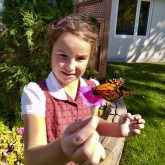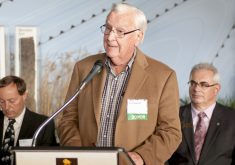To most of us, a bee is probably just a bee.
Sure, there’s honeybees, bumblebees, and whatever that bee is that lives in huts on farmers’ fields (leafcutters, of course). But otherwise, a bee’s a bee, right?
No, as it turns out.
Like cattle ranchers and horse breeders, beekeepers pay a lot of attention to their bees’ pedigrees and traits — disease resistance, overwintering ability, honey production, their temperaments and their adaptation to the harsh Manitoba producing environment.
Those who breed their own bees, like Tim Wendell who’s been raising them for at least 30 years, the perfect bee is pretty much the holy grail of their trade.
Read Also

What I learned about Manitoba eggs
Manitoba-laid eggs provide good, locally produced nutrition while supporting local farmers and the Canadian agriculture industry.
Bees in Manitoba
Technically, honeybees are an invasive species in Manitoba. Twenty species of honeybee are native to Europe, Asia and Africa, writes Ieuan Evans, a forensic plant pathologist, in a 2018 Grainews article.
Europeans “domesticated” bees as honey producers for thousands of years, he says.
“Until the Europeans settled the Americas, honeybees were unknown on this continent,” writes Evans.
Manitoba’s climate doesn’t make it easy for honeybees, who have a short window to raise new bees and produce honey before returning to a near hibernation state during the long winter.
For many years, beekeepers found it easier to import packages of bees from California and other southern U.S. states each year. They’d run the bees for a season, and gas most of them in the fall instead of overwintering them. In the spring, they’d start over.

Honey producer Tim Wendell’s farm straddles the Saskatchewan-Manitoba border near Roblin. He recalled how, in his teen years, his father brought in bees from Harrell, Alabama.
“They were called Harrell’s hornets because they flew backwards, pretty much,” Wendell said (he means they stung a lot).
“Oh they were mean,” said Wendell, adding he told his dad, “Anybody who does this for a living has no brains in their heads whatsoever.”
“That was 60 years ago, I suppose,” he added. “And here I am.”
Importing bees had a lot to do with economics, said Rheal Lafreniere, Manitoba’s provincial apiarist.
“You could actually depopulate your hives, your boxes and replenish them the next spring for probably less money than what it would have cost you to feed that colony and take the risk of losing some bees and having to buy some anyways,” he said.
Wintering was a lot of work, Wendell said. His dad would cut tarpaper, wrap hives and pack straw inside the paper. The tarpaper might split, driving a teenage Wendell nuts.
“Just the time and effort and frustration to do this, nobody wanted to do it,” he said.
In 1987, the Canadian Food Inspection Agency banned imports of American bee packages for phytosanitary reasons. Canadian beekeepers were still able to bring in bees from New Zealand and Australia, but the price of packaged bees shot up.
Suddenly, wintering became more important.
Wendell said he watched beekeepers out of Nipawin, Saskatchewan who had developed better methods of wintering. A provincial apiarist was advocating for beekeepers to develop their own “nucs” — starter bee colonies that can be used to replace queens and bees in depleted hives.
They were having success, which made Wendell think he needed to give it a go.
“It’s like driving a car the first time,” he said. “It looks easy but the reality of it is it’s not quite as easy as it looks.”
He grafted 30 to 50 queens the first year and overwintered them, and when most of them came through he tried a bigger batch the next year.
How do you breed a bee?
“Bee breeding” is mainly rearing of queens, the “mother bee” in all hives.
The process begins when a queen bee lays eggs. Worker bees decide to select one of those eggs and feed it massive amounts of a food called royal jelly, said Rob Currie, professor of entomology at the University of Manitoba. This turns that one egg into a queen.
Currie explained that when a beekeeper is trying to breed queens, they’ll graft an egg or young larva into a specific type of cell and put it into a colony, where the bees turn it into a queen cell. Once the queen hatches, it goes on mating flights and mates with whatever drones (male bees) the beekeeper has put in the area. The queen mates with several drones.
There’s also a technique for artificially inseminating queens.
“It’s a very tiny syringe,” said Currie.
Beekeepers choose to breed queens that have desirable traits. They may monitor the hives and measure the traits they’re looking for, then graft from that queen and rear replacement queens for themselves (most producers expect queens to last two years before they begin to deteriorate) or queens to sell.

While the majority of Manitoba beekeepers import queens from places like New Zealand, California, Hawaii and Chile, a growing minority rear their own.
With that comes some challenges.
“We offer a very challenging environment to raise queens, especially early queens… because our season is so short,” said Lafreniere.
While warmer climates have time to build up excess queens and produce honey, Manitoba rarely sees true spring until well into April. Sometimes producers need new queens right away to replace older, failing queens.
If they don’t have extra hives to steal a queen from, they’ll have little choice but to import queens, Lafreniere said.
Beekeepers who raise their own bees often still bring in stock from elsewhere to keep their gene pool from getting too shallow.
“Things have a tendency to go a little sideways over time,” Wendell said. “Your good breeder queen doesn’t last forever.”
Over the last three decades, Wendell has brought in bees from Ontario and Vancouver, and Russian bees by way of a scientific study in Baton Rouge, Louisiana. Now he imports bees from Denmark via the University of Guelph. They’re “Buckfast” bees, famously developed by Brother Adam of Buckfast Abbey in the United Kingdom.
“They don’t fly backwards. They’re quite gentle,” he said.
Benefits of local
There’s a strong correlation between producers breeding their own stock and greater adaptation to Manitoba conditions, said Lafreniere.
“You’re selecting for bees that perform very well under your management and also under the general Manitoba conditions,” he said.
Farmers who breed their own stock also have an advantage of self-sufficiency.
This spring, as the COVID-19 pandemic made the world batten down its hatches, it wasn’t possible to bring in queens or packages of bees from New Zealand, Australia or Chile.
While beekeepers could still import stock from California and Hawaii, said Lafreniere, it seemed to get many thinking about starting their own breeding program. People started contacting him for information.
“That probably got a lot of people thinking about, ‘boy oh boy, I should start being a little more self-sufficient,’” he said. “I know quite a few people who this is the first year they ever raised queens.”
Manitobans are still importing bees on a weekly basis, and that’s unlikely to stop soon because it has its place, Lafreniere said. However, he hoped the beekeepers who’ve chosen to try their hand at rearing would keep it up.
“I’m optimistic that more people will migrate to having more control over their business, become a little more self-reliant,” he said. “I’m hoping it’s addictive, because I do think it is a very good thing for this industry to have the ability to produce our own bees.”




















